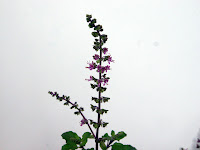FAMILY OF THE WEEK : LAMIACEAE (LABIATAE) MINT FAMILY
184 views
Skip to first unread message
satish phadke
Aug 6, 2008, 11:21:51 AM8/6/08
to indiantreepix Indian, wildflowerindia
FAMILY OF THE WEEK : LAMIACEAE (LABIATAE) MINT FAMILY


Ocimum sanctum

Pogostemon deccanensis

Leea (Dinda)
FAMILY OF THE WEEK : LAMIACEAE (LABIATAE) MINT FAMILY
Rather large family.The Mediterranean region is the chief centre of distribution. In India 64 genera and 380 species occurring chiefly in dry areas and moderate altitudes. The two chief centres of distribution are south India and North western India.The familiar examples include Mentha, Holy basil and Sage.
Vegetative characters:
Mostly annual or perennial herbs, sometimes shrubs or rarely small trees.
The stems of herbaceous species are often quadrangular.
The leaves are opposite bor sometimes whorled, exstipulate,simple and the blade is from entire to finely multisect as in Salvia.
They are abundantly loaded with epidermal glands secreting volatile aromatic oils which impart characteristic odour.
Inflorescence and flowers:
The inflorescence is usually a dichasial cyme which often becomes cincinal in its later branching.These cymes occur at the leaf axil and often form a whorl of flowers at each node. This type of inflorescence is often called as verticillaster. Each flower is subtendede by a bract and a pair of bracteoles.
The flowers are perfect, hermaphrodite,zygomorphic and hypogynous.
The calyx is persistent and composed of five sepals which show various degree of union.
The corolla is gamopetallous and is differentiated into a tube and a limb. The tube is straight or bent and often widens upwards. The limb is usually two lipped.
The stamens are usually four,didynamous and are inserted on the corolla tube.
The gynoecium is bicarpellary and syncarpous. The ovary is superior,deeply four lobed,bilocular.The stigma is usually bifid.
A hypogynous disc is present at the base of the ovary. It is usually four-lobed.
The fruit is of four one seeded nutlets enclosed by the persistent calyx.
Pollination: The bright coloured flowers with nectar secreting disc are adapted for insect pollination. They are mostly visited by moths and butterflies.
Examples:The Lamiaceae are chiefly valuable as a source of volatile essential oils which are used for flavouring, for perfumery and for medicine and some garden ornamentals.
Ocimum (Basil)Several species yield oils.
Ocimum sanctum(Holy Basil, Tulsi)
Ocimum americanum Ocimum canum(Ran tulas)
Ocimum grattissium(Shrubby basil)
Ocimum basilicum(Sweet basil, Kali Tulas)
Ocimum kilimandscharicum is a rich source of camphor.
Mentha. Several species are useful for essential oils.
Mentha pepperminta:Source of peppermint oil.
Mentha pulegium
Lavandula :source of lavender oil.
Pogostemon Plectranthus Thymus Salvia
Coleus : Herbs with variously coloured, variegated and showy foliage.
Colebrookea oppositifolia
Origanum majorana (Maarwa)
Leonotis
Leea


Ocimum sanctum

Pogostemon deccanensis

Leea (Dinda)
FAMILY OF THE WEEK : LAMIACEAE (LABIATAE) MINT FAMILY
Rather large family.The Mediterranean region is the chief centre of distribution. In India 64 genera and 380 species occurring chiefly in dry areas and moderate altitudes. The two chief centres of distribution are south India and North western India.The familiar examples include Mentha, Holy basil and Sage.
Vegetative characters:
Mostly annual or perennial herbs, sometimes shrubs or rarely small trees.
The stems of herbaceous species are often quadrangular.
The leaves are opposite bor sometimes whorled, exstipulate,simple and the blade is from entire to finely multisect as in Salvia.
They are abundantly loaded with epidermal glands secreting volatile aromatic oils which impart characteristic odour.
Inflorescence and flowers:
The inflorescence is usually a dichasial cyme which often becomes cincinal in its later branching.These cymes occur at the leaf axil and often form a whorl of flowers at each node. This type of inflorescence is often called as verticillaster. Each flower is subtendede by a bract and a pair of bracteoles.
The flowers are perfect, hermaphrodite,zygomorphic and hypogynous.
The calyx is persistent and composed of five sepals which show various degree of union.
The corolla is gamopetallous and is differentiated into a tube and a limb. The tube is straight or bent and often widens upwards. The limb is usually two lipped.
The stamens are usually four,didynamous and are inserted on the corolla tube.
The gynoecium is bicarpellary and syncarpous. The ovary is superior,deeply four lobed,bilocular.The stigma is usually bifid.
A hypogynous disc is present at the base of the ovary. It is usually four-lobed.
The fruit is of four one seeded nutlets enclosed by the persistent calyx.
Pollination: The bright coloured flowers with nectar secreting disc are adapted for insect pollination. They are mostly visited by moths and butterflies.
Examples:The Lamiaceae are chiefly valuable as a source of volatile essential oils which are used for flavouring, for perfumery and for medicine and some garden ornamentals.
Ocimum (Basil)Several species yield oils.
Ocimum sanctum(Holy Basil, Tulsi)
Ocimum americanum Ocimum canum(Ran tulas)
Ocimum grattissium(Shrubby basil)
Ocimum basilicum(Sweet basil, Kali Tulas)
Ocimum kilimandscharicum is a rich source of camphor.
Mentha. Several species are useful for essential oils.
Mentha pepperminta:Source of peppermint oil.
Mentha pulegium
Lavandula :source of lavender oil.
Pogostemon Plectranthus Thymus Salvia
Coleus : Herbs with variously coloured, variegated and showy foliage.
Colebrookea oppositifolia
Origanum majorana (Maarwa)
Leonotis
Leea
J.M. Garg
Aug 6, 2008, 12:55:12 PM8/6/08
to satish phadke, indiantreepix Indian
We have discussed the following plants from Lamiaceae on Indiantreepix:
For my Birds, Butterflies, Trees, Landscape pictures etc., visit http://commons.wikimedia.org/wiki/Special:Contributions/J.M.Garg
Reply all
Reply to author
Forward
0 new messages
